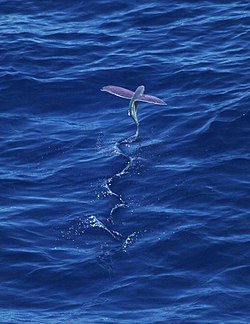Pleuston

Pleuston are the organisms that live in the thin surface layer existing at the air-water interface of a body of water as their habitat.[1] Examples include some cyanobacteria, some gastropods, the ferns Azolla and Salvinia and the seed plants Lemna, Wolffia, Pistia, Eichhornia crassipes and Hydrocharis. Some fungi and fungi-like protists may be also found.
Neuston
The term Neuston is used either:
- As a synonym for Pleuston: hence, the collective term for the organisms that float on the top of water (epineuston) or live right under the surface (hyponeuston).
- That subset of floating organisms that are microscopic[2] or those that rely on surface tension to float.[3] This is in comparison with the term pleuston, which is then its superset, including those organisms that float by buoyancy or are macroscopic.

Neustons, broadly defined, are made up of some species of fish (see flying fish[4]), beetles (see whirligig beetle), protozoans, bacteria and spiders (see fishing spider and diving bell spider). Springtails in the genera Podura and Sminthurides are almost exclusively neustonic, while Hypogastrura species often aggregate on pond surfaces. Water striders such as Gerris are common examples of insects that supports their weight on water's surface tension. By extension, the term may also refer to non-organismal floating aggregations (see, e.g., Great Pacific Garbage Patch).
Distinction versus other aquatic life
Plankton (organisms that float or drift within the water) are distinguished from nekton (organisms that swim, powerfully, in the water), and benthos (organisms on the bottom of a body of water).
References
- ^ "Pleuston". Merriam-Webster Online.
- ^ P. S. Liss, W. George N. Slinn (1983-07-31). Air-sea exchange of gases and particles. p. 148. ISBN 978-90-277-1610-1.
- ^ James H. Thorp, Alan P. Covich (2001-04-23). Ecology and classification of North American freshwater invertebrates. p. 34. ISBN 978-0-12-690647-9.
- ^ "The Sea Surface and Global Change by P. S. Liss, Robert A. Duce". google.com. Retrieved 9 June 2018.
External links
- "neuston - Britannica Online". Encyclopædia Britannica. Retrieved 2007-11-13.


